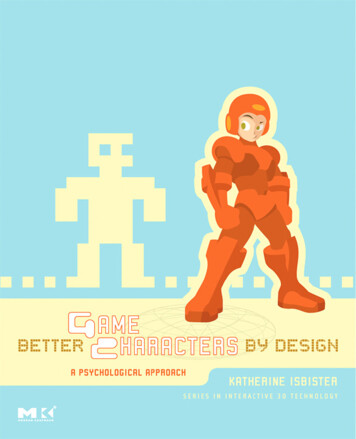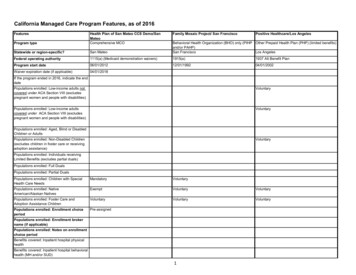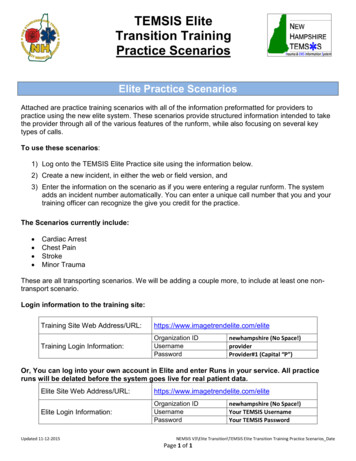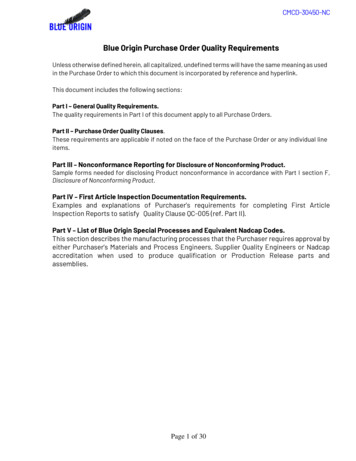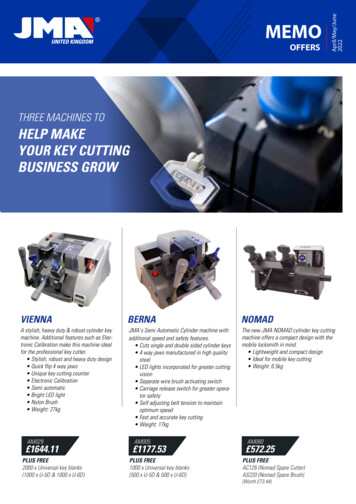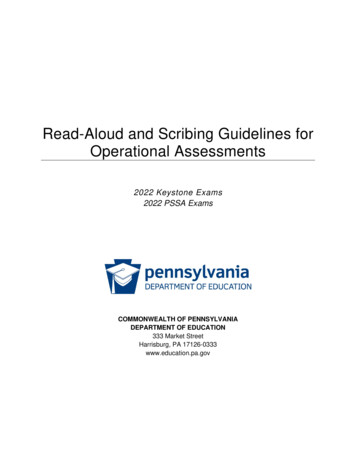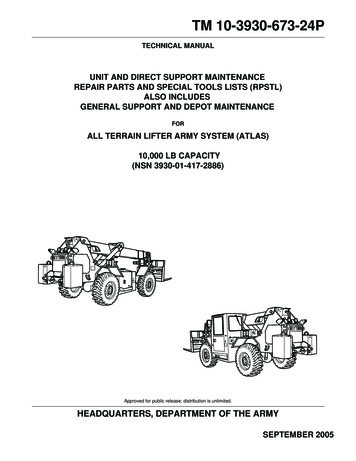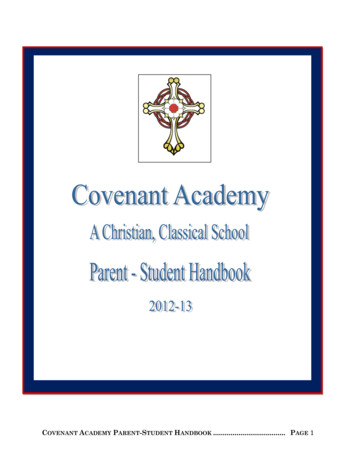
Transcription
This page intentionally left blank
Strategic ManagementCONCEPTS AND CASES
Editorial Director: Sally YaganEditor in Chief: Eric SvendsenAcquisitions Editor: Kim NorbutaProduct Development Manager: Ashley SantoraEditorial Project Manager: Claudia FernandesEditorial Assistant: Meg O’RourkeDirector of Marketing: Patrice Lumumba JonesMarketing Manager: Nikki Ayana JonesMarketing Assistant: Ian GoldSenior Managing Editor: Judy LealeAssociate Production Project Manager:Ana JankowskiOperations Specialist: Ilene KahnArt Director: Steve FrimText and Cover Designer: Judy AllanManager, Visual Research: Beth BrenzelManager, Rights and Permissions: Zina ArabiaImage Permission Coordinator: Cynthia VincentiManager, Cover Visual Research & Permissions:Karen SanatarCover Art: Vetta TM Collection Dollar Bin:istockphotoEditorial Media Project Manager: Ashley LullingProduction Media Project Manager: Lisa RinaldiFull-Service Project Management: Thistle HillPublishing Services, LLCComposition: Integra Software Services, Ltd.Printer/Binder: Courier/KendallvilleCover Printer: Lehigh-Phoenix Color/HagerstownText Font: 10/12 TimesCredits and acknowledgments borrowed from other sources and reproduced, with permission, in this textbookappear on appropriate page within text.Copyright 2011, 2009, 2007 by Pearson Education, Inc., publishing as Prentice Hall, One Lake Street,Upper Saddle River, New Jersey 07458. All rights reserved. Manufactured in the United States of America.This publication is protected by Copyright, and permission should be obtained from the publisher prior to anyprohibited reproduction, storage in a retrieval system, or transmission in any form or by any means, electronic,mechanical, photocopying, recording, or likewise. To obtain permission(s) to use material from this work,please submit a written request to Pearson Education, Inc., Permissions Department, One Lake Street, UpperSaddle River, New Jersey 07458.Many of the designations by manufacturers and seller to distinguish their products are claimed as trademarks.Where those designations appear in this book, and the publisher was aware of a trademark claim, thedesignations have been printed in initial caps or all caps.Library of Congress Cataloging-in-Publication DataDavid, Fred R.Strategic management: concepts and cases / Fred R. David.—13th ed.p. cm.Includes bibliographical references and index.ISBN-13: 978-0-13-612098-8 (casebound)ISBN-10: 0-13-612098-9 (casebound)1. Strategic planning. 2. Strategic planning—Case studies. I. Title.HD30.28.D385 2011658.4'012—dc22200905203610 9 8 7 6 5 4 3 2ISBN 10:0-13-612098-9ISBN 13: 978-0-13-612098-8
THIRTEENTH EDITIONStrategic ManagementCONCEPTS AND CASESFred R. DavidFrancis Marion UniversityFlorence, South CarolinaPrentice HallBoston Columbus Indianapolis New York San Francisco Upper Saddle RiverAmsterdam Cape Town Dubai London Madrid Milan Munich Paris Montreal TorontoDelhi Mexico City Sao Paulo Sydney Hong Kong Seoul Singapore Taipei Tokyo
To Joy, Forest, Byron, and Meredith—my wife and children—for their encouragement and love.
This page intentionally left blank
This page intentionally left blank
Brief ContentsPreface xviiAbout the Author xxviiPart 4Strategy Evaluation 284Part 1Overview of Strategic Management 2Chapter 9Strategy Review, Evaluation,and Control 284Acknowledgments xxiiiChapter 1The Nature of Strategic Management 2THE COHESION CASE: MCDONALD’S — 2009 27Part 5Key Strategic-Management Topics 308Part 2Strategy Formulation 40Chapter 10Business Ethics/Social Responsibility/Environmental Sustainability 308Chapter 2The Business Vision and Mission 40Chapter 11Global/International Issues 328Chapter 3The External Assessment 58Part 6Strategic-Management CaseAnalysis 346Chapter 4The Internal Assessment 90Chapter 5Strategies in Action 130Chapter 6Strategy Analysis and Choice 172How to Prepare and Presenta Case Analysis 346Name Index 359Subject Index 363Part 3Strategy Implementation 210Chapter 7Implementing Strategies: Managementand Operations Issues 210Chapter 8Implementing Strategies: Marketing, Finance/Accounting, R&D, and MIS Issues 250vii
This page intentionally left blank
ContentsPreface xviiAcknowledgments xxiiiAbout the Author xxviiPart 1Overview of Strategic Management 2Chapter 1The Nature of Strategic Management 2MCDONALD’S CORPORATION: DOING GREATIN A WEAK ECONOMY 4What Is Strategic Management? 5Defining Strategic Management 6 & Stages ofStrategic Management 6 & Integrating Intuitionand Analysis 7 & Adapting to Change 8Key Terms in Strategic Management 9Competitive Advantage 9 & Strategists 10 & Vision and MissionStatements 11 & External Opportunities and Threats 11&Internal Strengths and Weaknesses 12 & Long-Term Objectives 13& Strategies 13 & Annual Objectives 13 & Policies 14The Strategic-Management Model 14Benefits of Strategic Management 16Financial Benefits 17 & Nonfinancial Benefits 18Why Some Firms Do No Strategic Planning 18Pitfalls in Strategic Planning 19Guidelines for Effective Strategic Management 19Comparing Business and Military Strategy 21THE COHESION CASE: MCDONALD’SCORPORATION—2009 27ASSURANCE OF LEARNING EXERCISES 37Assurance of Learning Exercise 1A: Gathering StrategyInformation 37Assurance of Learning Exercise 1B: Strategic Planningfor My University 37Assurance of Learning Exercise 1C: Strategic Planningat a Local Company 38Assurance of Learning Exercise 1D: Getting Familiar with SMCO 38Part 2Strategy Formulation 40Chapter 2The Business Vision and Mission 40WAL-MART: DOING GREAT IN A WEAK ECONOMY 42What Do We Want to Become? 43What Is Our Business? 43Vision versus Mission 45 & The Process of Developing Visionand Mission Statements 46Importance (Benefits) of Vision and MissionStatements 47A Resolution of Divergent Views 48Characteristics of a Mission Statement 49A Declaration of Attitude 49 & A CustomerOrientation 50 & Mission Statement Components 51Writing and Evaluating Mission Statements 53ASSURANCE OF LEARNING EXERCISES 56Assurance of Learning Exercise 2A: Evaluating MissionStatements 56Assurance of Learning Exercise 2B: Writing a Vision and MissionStatement for McDonald’s Corporation 56Assurance of Learning Exercise 2C: Writing a Vision and MissionStatement for My University 57Assurance of Learning Exercise 2D: Conducting Mission StatementResearch 57Chapter 3The External Assessment 58DUNKIN' BRANDS, INC.: DOING GREAT IN A WEAKECONOMY 60The Nature of an External Audit 61Key External Forces 61 & The Process of Performing an ExternalAudit 62The Industrial Organization (I/O) View 63Economic Forces 63Social, Cultural, Demographic, and Natural EnvironmentForces 66Political, Governmental, and Legal Forces 68Technological Forces 69Competitive Forces 71Competitive Intelligence Programs 72 & Market Commonalityand Resource Similarity 74Competitive Analysis: Porter’s Five-ForcesModel 74Rivalry Among Competing Firms 75 & Potential Entry ofNew Competitors 76 & Potential Development of SubstituteProducts 77 & Bargaining Power of Suppliers 77 & BargainingPower of Consumers 77Sources of External Information 78Forecasting Tools and Techniques 78Making Assumptions 79ix
xCONTENTSIndustry Analysis: The External Factor Evaluation (EFE)Matrix 80The Competitive Profile Matrix (CPM) 81ASSURANCE OF LEARNING EXERCISES 86Assurance of Learning Exercise 3A: Developing an EFE Matrix forMcDonald’s Corporation 86Assurance of Learning Exercise 3B: The ExternalAssessment 86Assurance of Learning Exercise 3C: Developing an EFE Matrix forMy University 87Assurance of Learning Exercise 3D: Developing a CompetitiveProfile Matrix for McDonald’s Corporation 87Assurance of Learning Exercise 3E: Developing a CompetitiveProfile Matrix for My University 87Chapter 4The Internal Assessment 90AMAZON.COM, INC.: DOING GREAT IN A WEAKECONOMY. HOW? 92The Nature of an Internal Audit 93Key Internal Forces 93 & The Process of Performing an InternalAudit 93The Resource-Based View (RBV) 96Integrating Strategy and Culture 97Management 99Planning 100 & Organizing 100 & Motivating 101 & Staffing102 & Controlling 102 & Management Audit Checklist ofQuestions 103Marketing 103Customer Analysis 103 & Selling Products/Services 103 &Product and Service Planning 104 & Pricing 105 & Distribution105 & Marketing Research 106 & Cost/Benefit Analysis 106 &Marketing/Audit Checklist of Questions 106Finance/Accounting 106Finance/Accounting Functions 107 & Basic Types of FinancialRatios 108 & Finance/Accounting Audit Checklist 113Production/Operations 113Production/Operations Audit Checklist 115Research and Development 115Internal and External R&D 116 & Research and DevelopmentAudit 117Management Information Systems 117Strategic-Planning Software 118 & Management InformationSystems Audit 119Value Chain Analysis (VCA) 119Benchmarking 120The Internal Factor Evaluation (IFE) Matrix 122Chapter 5Strategies in Action 130VOLKSWAGEN AG: DOING GREAT IN A WEAKECONOMY. HOW? 132Long-Term Objectives 133The Nature of Long-Term Objectives 133 & Financial versusStrategic Objectives 134 & Not Managing byObjectives 135The Balanced Scorecard 135Types of Strategies 136Levels of Strategies 138Integration Strategies 139Forward Integration 139 & Backward Integration 140& Horizontal Integration 141Intensive Strategies 141Market Penetration 141 & Market Development 142& Product Development 142Diversification Strategies 143Related Diversification 144 & Unrelated Diversification 144Defensive Strategies 146Retrenchment 146 & Divestiture 148 & Liquidation 149Michael Porter’s Five Generic Strategies 151Cost Leadership Strategies (Type 1 and Type 2) 152 & DifferentiationStrategies (Type 3) 153 & Focus Strategies (Type 4 and Type 5) 154& Strategies for Competing in Turbulent, High-VelocityMarkets 155Means for Achieving Strategies 155Cooperation Among Competitors 155 & Joint Venture/Partnering 156 & Merger/Acquisition 158 & First MoverAdvantages 161 & Outsourcing 161Strategic Management in Nonprofit and GovernmentalOrganizations 162Educational Institutions 162 & Medical Organizations 163& Governmental Agencies and Departments 163Strategic Management in Small Firms 164ASSURANCE OF LEARNING EXERCISES 168Assurance of Learning Exercise 5A: What Strategies ShouldMcDonald’s Pursue in 2011–2013? 168Assurance of Learning Exercise 5B: Examining Strategy Articles 168Assurance of Learning Exercise 5C: Classifying Some Year 2009Strategies 169Assurance of Learning Exercise 5D: How Risky Are VariousAlternative Strategies? 169Assurance of Learning Exercise 5E: Developing AlternativeStrategies for My University 170Assurance of Learning Exercise 5F: Lessons in Doing BusinessGlobally 170ASSURANCE OF LEARNING EXERCISES 128Assurance of Learning Exercise 4A: Performing a Financial RatioAnalysis for McDonald’s Corporation (MCD) 128Assurance of Learning Exercise 4B: Constructing an IFE Matrix forMcDonald’s Corporation 128Assurance of Learning Exercise 4C: Constructing an IFE Matrix forMy University 128Chapter 6Strategy Analysis and Choice 172APPLE: DOING GREAT IN A WEAK ECONOMY. HOW? 174The Nature of Strategy Analysis and Choice 175The Process of Generating and Selecting Strategies 175
CONTENTSA Comprehensive Strategy-Formulation Framework 176The Input Stage 177The Matching Stage 177The Strengths-Weaknesses-Opportunities-Threats (SMOT) Matrix178 & The Strategic Position and Action Evaluation (SPACE)Matrix 181 & The Boston Consulting Group (BCG) Matrix 185 &The Internal-External (IE) Matrix 188 & The Grand StrategyMatrix 191The Decision Stage 192The Quantitative Strategic Planning Matrix (QSPM) 192& Positive Features and Limitations of the QSPM 195Cultural Aspects of Strategy Choice 196The Politics of Strategy Choice 196Governance Issues 198ASSURANCE OF LEARNING EXERCISES 205Assurance of Learning Exercise 6A: Developing a SWOT Matrix forMcDonald’s 205Assurance of Learning Exercise 6B: Developing a SPACE Matrix forMcDonald’s 205Assurance of Learning Exercise 6C: Developing a BCG Matrix forMcDonald’s 205Assurance of Learning Exercise 6D: Developing a QSPM forMcDonald’s 206Assurance of Learning Exercise 6E: Formulating IndividualStrategies 206Assurance of Learning Exercise 6F: The Mach Test 206Assurance of Learning Exercise 6G: Developing a BCG Matrix forMy University 208Assurance of Learning Exercise 6H: The Role of Boards ofDirectors 208Assurance of Learning Exercise 6I: Locating Companies in a GrandStrategy Matrix 209Part 3Strategy Implementation 210Chapter 7Implementing Strategies: Managementand Operations Issues 210GOOGLE: DOING GREAT IN A WEAK ECONOMY.HOW? 212The Nature of Strategy Implementation 213Management Perspectives 214Annual Objectives 215Policies 217Resource Allocation 219Managing Conflict 220Matching Structure with Strategy 220The Functional Structure 222 & The Divisional Structure 222& The Strategic Business Unit (SBU) Structure 225 & The MatrixStructure 226 & Some Do’s and Don’ts in DevelopingOrganizational Charts 228Restructuring, Reengineering, and E-Engineering 229Restructuring 230 & Reengineering 231xiLinking Performance and Pay toStrategies 231Managing Resistance to Change 234Creating a Strategy-Supportive Culture 235Production/Operations Concerns When ImplementingStrategies 236Human Resource Concerns When ImplementingStrategies 237Employee Stock Ownership Plans (ESOPs) 239 & Balancing WorkLife and Home Life 240 & Benefits of a Diverse Workforce 242& Corporate Wellness Programs 242ASSURANCE OF LEARNING EXERCISES 248Assurance of Learning Exercise 7A: Revising McDonald’sOrganizational Chart 248Assurance of Learning Exercise 7B: Do Organizations ReallyEstablish Objectives? 248Assurance of Learning Exercise 7C: Understanding My University’sCulture 249Chapter 8Implementing Strategies: Marketing,Finance/Accounting, R&D, and MISIssues 250The Nature of Strategy Implementation 252JOHNSON & JOHNSON (J&J): DOING GREAT IN A WEAKECONOMY. HOW? 252Current Marketing Issues 253New Principles of Marketing 254 & Advertising Media 256& Purpose-Based Marketing 257Market Segmentation 257Does the Internet Make Market Segmentation Easier? 259Product Positioning 260Finance/Accounting Issues 261Acquiring Capital to Implement Strategies 262New Source of Funding 266 & Projected FinancialStatements 266 & Projected Financial Statement forMattel, Inc. 268 & Financial Budgets 271 & Evaluatingthe Worth of a Business 273 & Deciding Whether toGo Public 275Research and Development (R&D) Issues 275Management Information Systems (MIS) Issues 277ASSURANCE OF LEARNING EXERCISES 282Assurance of Learning Exercise 8A: Developing a ProductPositioning Map for McDonald’s 282Assurance of Learning Exercise 8B: Performing an EPS/EBITAnalysis for McDonald’s 282Assurance of Learning Exercise 8C: Preparing Projected FinancialStatements for McDonald’s 282Assurance of Learning Exercise 8D: Determining the Cash Value ofMcDonald’s 283Assurance of Learning Exercise 8E: Developing a ProductPositioning Map for My University 283Assurance of Learning Exercise 8F: Do Banks Require ProjectedFinancial Statements? 283
xiiCONTENTSPart 4Strategy Evaluation 284Chapter 9Strategy Review, Evaluation, andControl 284FAMILY DOLLAR STORES: DOING GREAT IN A WEAKECONOMY. HOW? 286The Nature of Strategy Evaluation 286The Process of Evaluating Strategies 290A Strategy-Evaluation Framework 290Reviewing Bases of Strategy 290 & Measuring OrganizationalPerformance 292 & Taking Corrective Actions 294The Balanced Scorecard 295Published Sources of Strategy-EvaluationInformation 297Characteristics of an Effective Evaluation System 298Contingency Planning 299Auditing 300Twenty-First-Century Challenges in StrategicManagement 301The Art of Science Issue 301 & The Visible or Hidden Issue 301& The Top-Down or Bottom-Up Approach 302ASSURANCE OF LEARNING EXERCISES 306Assurance of Learning Exercise 9A: Preparing a Strategy-EvaluationReport for McDonald’s Corp. 306Assurance of Learning Exercise 9B: Evaluating My University’sStrategies 306Part 5Key Strategic-Management Topics 308Chapter 10Business Ethics/Social Responsibility/Environmental Sustainability 308WALT DISNEY: DOING GREAT IN A WEAK ECONOMY.HOW? 310Business Ethics 311Code of Business Ethics 312 & An Ethics Culture 313 & Bribes314 & Love Affairs at Work 314Social Responsibility 315Social Policy 315 & Social Policies on Retirement 316Environmental Sustainability 317What Is a Sustainability Report? 317 & Lack of StandardsChanging 318 & Obama Regulations 318 & ManagingEnvironmental Affairs in the Firm 319 & Should Students ReceiveEnvironmental Training? 319 & Reasons Why Firms Should “BeGreen” 320 & Be Proactive, Not Reactive 320 & ISO14000/14001 Certification 320 & Electric Car Networks AreComing 321 & The March 2009 Copenhagen Meeting 322ASSURANCE OF LEARNING EXERCISES 326Assurance of Learning Exercise 10A: Does McDonald’s Have aCode of Business Ethics? 326Assurance of Learning Exercise 10B: The Ethics of Spying onCompetitors 326Assurance of Learning Exercise 10C: Who Prepares a SustainabilityReport? 327Chapter 11Global/International Issues 328MARRIOTT INTERNATIONAL: DOING GREAT IN A WEAKECONOMY. HOW? 330Multinational Organizations 331Advantages and Disadvantages of InternationalOperations 332The Global Challenge 333Globalization 334 & A Weak Economy 335United States versus Foreign Business Cultures 335The Mexican Culture 337 & The Japanese Culture 338 &Communication Differences Across Countries 338Worldwide Tax Rates 339Joint Ventures in India 339ASSURANCE OF LEARNING EXERCISES 343Assurance of Learning Exercise 11A: McDonald’s Wants to EnterAfrica. Help Them. 343Assurance of Learning Exercise 11B: Does My University Recruit inForeign Countries? 343Assurance of Learning Exercise 11C: Assessing Differences inCulture Across Countries 343Assurance of Learning Exercise 11D: How Well Traveled AreBusiness Students at Your University? 344Part 6Strategic-Management Case Analysis 346How to Prepare and Present a CaseAnalysis 346What Is a Strategic-Management Case? 348Guidelines for Preparing Case Analyses 348The Need for Practicality 348 & The Need forJustification 348 & The Need for Realism 348 & The Need forSpecificity 349 & The Need for Originality 349 & The Need toContribute 349Preparing a Case for Class Discussion 349The Case Method versus Lecture Approach 349 & The CrossExamination 350Preparing a Written Case Analysis 350The Executive Summary 350 & The Comprehensive WrittenAnalysis 351 & Steps in Preparing a Comprehensive WrittenAnalysis 351Making an Oral Presentation 351Organizing the Presentation 351 & Controlling YourVoice 352 & Managing Body Language 352 & Speaking fromNotes 352 & Constructing Visual Aids 352 & AnsweringQuestions 353 & Tips for Success in Case Analysis 353 &Content Tips 353 & Process Tips 354 & Sample Case AnalysisOutline 355
CONTENTSSTEPS IN PRESENTING AN ORAL CASE ANALYSIS 356Oral Presentation—Step 1: Introduction (2 minutes) 356Oral Presentation—Step 2: Mission/Vision (4 minutes) 356Oral Presentation—Step 3: Internal Assessment (8 minutes) 356Oral Presentation—Step 4: External Assessment (8 minutes) 357Oral Presentation—Step 5: Strategy Formulation (14 minutes) 357xiiiOral Presentation—Step 6: Strategy Implementation (8 minutes) 357Oral Presentation—Step 7: Strategy Evaluation (2 minutes) 358Oral Presentation—Step 8: Conclusion (4 minutes) 358Name Index 359Subject Index 363
xivCONTENTSCasesHOSPITALITY/ENTERTAINMENT1. Walt Disney Company — 2009, Mernoush Banton12. Merryland Amusement Park — 2009, Gregory Stone14AIRLINES3. JetBlue Airways Corporation — 2009, Mernoush Banton4. AirTran Airways, Inc. — 2009, Charles M. Byles2637RETAIL STORES5. Family Dollar Stores, Inc. — 2009, Joseph W. Leonard506. Wal-Mart Stores, Inc. — 2009, Amit J. Shah and Michael L. Monahanat7. Whole Foods Market, Inc. — 2009, James L. Harbin and PatriciaHumphrey738. Macy’s, Inc. — 2009, Rochelle R. Brunson and Marlene M. Reed83INTERNET BASED9. Yahoo! Inc. — 2009, Hamid Kazeroony10. eBay Inc. — 2009, Lori Radulovich9199FINANCIAL11. Wells Fargo Corporation — 2009, Donald L. Crooks, Robert S. Goodman,and John Burbridge111RESTAURANTS12. Krispy Kreme Doughnuts (KKD) — 2009, John Burbridge andColeman Rich12013. Starbucks Corporation — 2009, Sharynn Tomlin129NONPROFIT14. The United States Postal Service (USPS) — 2009, Fred andForest David 13815. National Railroad Passenger Corporation (AMTRAK) — 2009,Kristopher J. Blanchard15016. Goodwill of San Francisco, San Mateo and Marin Counties — 2009,Mary E. Vradelis 158TRANSPORTATION17. Harley-Davidson, Inc. — 2009, Carol Pope and Joanne Mack18. Ford Motor Company — 2009, Alen Badal166176FOOD19. Kraft Foods Inc. — 2009, Kristopher J. Blanchard18420. Hershey Company — 2009, Anne Walsh and Ellen MansfieldPERSONAL CARE21. Johnson & Johnson — 2009, Sharynn Tomlin, Matt Milhauser,Bernhard Gierke, Thibault Lefebvre, and Mario Martinez20122. Avon Products Inc. — 2009, Rochelle R. Brunson andMarlene M. Reed212BEVERAGE23. Molson Coors — 2009, Amit J. Shah24. PepsiCo — 2009, John and Sherry Ross22023219259
CONTENTSHEALTH CARE25. Pfizer, Inc. — 2009, Vijaya Narapareddy24326. Merck & Company Inc. — 2010, Mernoush Banton252SPORTS27. Nike, Inc. — 2010, Randy Harris26128. Callaway Golf Company — 2009, Amit J. Shah272ENERGY29. Chevron Corporation — 2009, Linda Herkenhoff282xv
This page intentionally left blank
PrefaceWhy the Need for This New Edition?The global economic recession has created a business world today that is quite differentand more complex than it was just two years ago when the previous edition of this textwas published. Thousands of businesses have vanished, and consumers have becomeextremely price sensitive and oftentimes reluctant purchasers of products and services.Very tight credit markets, high unemployment, and millions of new entrepreneurs havealso changed the business landscape. Business firms that have survived the last threeyears of global economic turmoil are today leaner and meaner than ever before.Gaining and sustaining competitive advantage is harder than ever. Social networkingand e-commerce have altered marketing to its core since the prior edition. This new edition reveals how to conduct effective strategic planning in this new world order.Since the prior edition, thousands of liquidations, bankruptcies, divestitures, mergers, alliances, and partnerships captured the news. Corporate scandals highlighted theneed for improved business ethics and corporate disclosure of financial transactions.Downsizing, rightsizing, and reengineering contributed to a permanently altered corporate landscape. Thousands of firms began doing business globally, and thousands moreclosed their global operations. Thousands prospered, and yet thousands failed in the lasttwo years as the global recession spared few. Long-held competitive advantages haveeroded as new ones formed. This new edition captures the complexity of this world business environment.Both the challenges and opportunities facing organizations of all sizes today aregreater than ever. There is less room than ever for error in the formulation and implementation of a strategic plan. This new edition provides a systematic effective approachfor developing a clear strategic plan, even in the worst of times. Changes made in thisedition are aimed squarely at illustrating the effect of new business concepts and techniques on strategic-management theory and practice.Due to the magnitude of recent changes affecting companies, cultures, and countries,every page of this edition has been updated. The first edition of this text was published in1986. Since then, this textbook has grown to be one of the most widely read strategicmanagement books, perhaps the most widely read, in the world. This text is now publishedin nine languages.What Is New in This Edition?This edition includes exciting new features, changes, and content designed to position thistext as the clear leader and best choice for teaching strategic management. Here is a summary of what is new in this edition: A new Chapter 10, “Business Ethics/Social Responsibility/EnvironmentalSustainability”; there is extensive new coverage of ethics and sustainability because thistext emphasizes that “good ethics is good business.” Unique to strategic-managementtexts, the natural environment discussion is strengthened in this edition to promote andencourage firms to conduct operations in an environmentally sound manner. Respect forthe natural environment has become an important concern for consumers, companies,society, and AACSB-International. A new Chapter 11, “Global/International Issues”; there is extensive new coverageof cultural and conceptual strategic-management differences across countries.Doing business globally has become a necessity, rather than a luxury in mostindustries because nearly all strategic decisions today are affected by global
xviiiPREFACE issues and concerns. Every case company in this edition does business globally,providing students ample opportunity to evaluate and consider internationalaspects of doing business.A new boxed insert at the beginning of each chapter showcases a company that hasdone exceptionally well in the 2008–2010 global economic recession and reveals theirstrategy.Hundreds of new examples abound in every chapter.A new cohesion case on McDonald’s Corporation (2010); this is one of the mostsuccessful, well-known, and best managed global companies in the world; studentsapply strategy concepts to McDonald’s at the end of each chapter through newAssurance of Learning Exercises.Thirty-two new tables in the chapters to better capture key strategic-managementconcepts.A revised comprehensive strategic management model to reflect the new chapters.Extensive new narrative on strategic management theory and concepts in everychapter to illustrate the new business world order.On average, 15 new review questions at the end of each chapter.Forty-eight new Assurance of Learning Exercises at the end of chapters that applychapter concepts; the exercises prepare students for strategic-management caseanalysis.Twenty-four new color photographs bring the edition to life and illustratecompanies/concepts.All new current readings at the end of each chapter; new research and theories ofseminal thinkers in strategy development, such as Ansoff, Chandler, Porter,Hamel, Prahalad, Mintzberg, and Barney are provided in the chapters; practicalaspects of strategic management, however, are still center stage and the trademarkof this text below.Twenty-nine new cases—grouped by industry; great mix of profit/nonprofit,large/small, and manufacturing/service organizations; all the cases have a2009–2010 time setting; all the cases are “comprehensive” in the sense that eachfocuses on multiple business functions, rather than addressing one particular business problem or issue; all the cases are undisguised and feature real organizationsin real industries using real names and real places (nothing is fictitious in anycase); all the cases feature an organization “undergoing strategic change,” thusoffering students up-to-date issues to evaluate and consider; all the cases arewritten in a lively, concise writing style that captures the reader’s interest andestablishes a time setting, usually in the opening paragraph; all the cases provideexcellent quantitative information such as numbers, ratios, percentages, dollar values, graphs, statistics, and maps so students can prepare a more specific, rational,and defensible strategic plan for the organization; all the cases provide excellentinformation about the industry and competitors.This edition continues to offer many special time-tested features and content that havemade this text so successful for over 20 years. Historical trademarks of this text that arestrengthened in this edition are described below.Chapters: Time-Tested Features This text meets AACSB-International guidelines that support a practitioner orientation rather than a theory/research approach. It offers a skills-oriented approachto developing a vision and mission statement; performing an external audit; conducting an internal assessment; and formulating, implementing, and evaluatingstrategies. The author’s writing style is concise, conversational, interesting, logical, lively, andsupported by numerous current examples throughout.
PREFACE A simple, integrative strategic-management model appears in all chapters and on theinside front cover of the text. This model is widely used for strategic planningamong consultants and companies worldwide. One reviewer said, “One thing I haveadmired about David’s text is that he follows the fundamental sequence of strategyformulation, implementation, and evaluation. There is a basic flow frommission/purposes to internal/external environmental scanning to strategy development, selection, implementation, and evaluation. This has been, and continues to be,a hallmark of the David text. Many other strategy texts are more disjointed in theirpresentation, and thus confusing to the student, especially at the undergraduatelevel.” A Cohesion Case follows Chapter 1 and is revisited at the end of each chapter. ThisCohesion Case allows students to apply strategic-management concepts and techniques to a real organization as chapter material is covered, which readies studentsfor case analysis in the course. End-of-chapter Assurance of Learning Exercises effectively apply conceptsand techniques in a challenging, meaningful, and enjoyable manner. Eighteenexercises apply text material to the Cohesion Case; 10 apply textual material toa college or university; another 10 exercises send students into the business worldto explore important strategy topics. The exercises are relevant, interesting, andcontemporary. There is excellent pedagogy in this text, including notable quotes and objectives toopen each chapter, and key terms, current readings, discussion questions, and experiential exercises to close each chapter. There is excellent coverage of strategy formulation issues, such as business ethi
Editorial Director: Sally Yagan Editor in Chief: Eric Svendsen Acquisitions Editor: Kim Norbuta Product Development Manager: Ashley Santora Editorial Project Manager: Claudia Fernandes Editorial Assistant: Meg O'Rourke Director of Marketing: Patrice Lumumba Jones Marketing Manager: Nikki Ayana Jones Marketing Assistant: Ian Gold Senior Managing Editor: Judy Leale .
